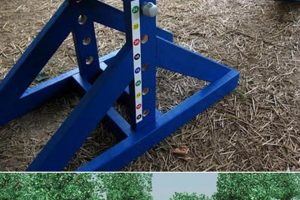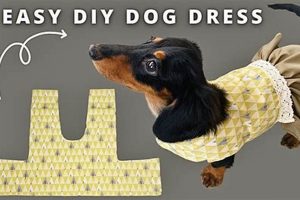The practice of concealing medication within palatable food items represents a common strategy for administering pills to canine companions. This method addresses the challenges pet owners face when dogs exhibit reluctance or resistance to swallowing medication directly. For example, a soft, moldable treat can encase a tablet, masking its taste and texture to facilitate ingestion.
Employing homemade solutions to this challenge offers several potential advantages. It allows for control over the ingredients, catering to specific dietary needs or sensitivities. It can also provide a cost-effective alternative to commercially manufactured products. Historically, concealing medication in food has been a longstanding approach, predating the availability of specialized products and reflecting resourcefulness in pet care.
The subsequent sections will delve into recipes for creating these homemade medication delivery vehicles, outline best practices for their use, and discuss considerations related to safety and efficacy.
Tips for Crafting Effective Homemade Medication Concealment Treats
The following recommendations aim to enhance the success rate and safety profile of utilizing homemade treats for medication administration in canines.
Tip 1: Prioritize Palatability: Select ingredients known to be highly appealing to the target animal. Peanut butter, cream cheese (in moderation), or cooked meats can effectively mask the taste of medication.
Tip 2: Consistency is Key: Maintain a soft, pliable texture to ensure easy molding around the pill. A dry or crumbly treat may not adequately conceal the medication, leading to rejection.
Tip 3: Size Appropriateness: The treat should be sized adequately to fully encapsulate the pill without being excessively large. A smaller size minimizes chewing and reduces the likelihood of the dog detecting the medication.
Tip 4: Monitor for Allergies: Exercise caution when introducing new ingredients to the diet. Observe for any signs of allergic reaction, such as skin irritation, gastrointestinal upset, or facial swelling.
Tip 5: Consult a Veterinarian: Before implementing a homemade medication administration strategy, consult with a veterinary professional. They can offer guidance on appropriate ingredients based on the dog’s health status and medication compatibility.
Tip 6: Batch Preparation and Storage: Prepare treats in small batches to maintain freshness and prevent spoilage. Store them in an airtight container in the refrigerator for optimal preservation.
Tip 7: Observe Consumption: After administering the treat, carefully observe the dog to ensure complete ingestion. If the pill is refused or partially chewed, adjust the recipe or administration method accordingly.
Adhering to these suggestions can significantly improve medication compliance and reduce the stress associated with pill administration, benefiting both the animal and the owner.
The subsequent discussion will explore potential recipe formulations for creating these effective and safe medication concealment options.
1. Ingredient Selection
Ingredient selection is paramount in the creation of effective medication-delivery treats for canines. The components directly influence palatability, allergenicity, and the potential for interaction with the medication itself. The failure to carefully consider ingredient profiles can lead to medication refusal, adverse reactions, or reduced drug efficacy. For instance, using ingredients known to be allergenic to a specific dog can result in dermatological or gastrointestinal distress, undermining the purpose of medication administration.
Furthermore, certain food substances can interfere with the absorption or metabolism of specific medications. An example is the potential interaction between tetracycline antibiotics and dairy products, which can decrease drug absorption. Therefore, a thorough understanding of potential food-drug interactions is crucial. The base ingredient for the pill pocket, binding agents, and flavor enhancers must each be assessed for safety and compatibility. Opting for single-ingredient solutions or consulting a veterinarian about ingredient compatibility will minimize risk. Consider also the nutritional value of the ingredients. Treats used frequently to administer medications should contribute to a balanced diet.
In conclusion, informed selection of ingredients is not merely a matter of taste preference; it’s a critical safety and efficacy consideration in the fabrication of homemade medication-delivery treats. It requires careful evaluation of potential allergens, drug interactions, and nutritional value to ensure the well-being of the animal. Thoughtful ingredient selection mitigates risks and facilitates the consistent and successful administration of prescribed medications.
2. Texture consistency
Texture consistency within homemade medication-delivery treats significantly impacts canine acceptance and successful pill administration. The primary cause-and-effect relationship centers on the dog’s sensory experience: an optimally pliable texture allows for effective encapsulation of the medication, masking its taste and minimizing detection. In contrast, a texture that is either too hard, too crumbly, or too sticky can lead to rejection of the treat, rendering the medication undelivered. For example, if the treat is too dry, it may crumble upon manipulation, exposing the pill and alerting the dog to its presence. Alternatively, an excessively sticky texture can adhere to the dog’s palate, creating an unpleasant experience that discourages future acceptance.
The importance of appropriate texture lies in its direct influence on medication compliance. A well-crafted treat, characterized by its ability to mold readily around the pill without crumbling or sticking, enhances the likelihood of seamless ingestion. This outcome is particularly crucial for dogs exhibiting pre-existing medication aversion. A real-world example involves a dog requiring daily antibiotics, where a consistent, soft treat texture successfully concealed the medication for weeks, whereas prior attempts with less pliable alternatives had resulted in consistent refusal. A proper texture also minimizes chewing. Reduced chewing equates to less pill exposure, further helping to mask the medication.
In conclusion, texture consistency is a pivotal factor in the success of homemade medication-delivery treats. Achieving the right consistency mitigates potential sensory aversion, promotes seamless ingestion, and ultimately contributes to improved medication compliance. The challenge lies in formulating recipes and employing techniques that reliably yield a consistently palatable and easily manipulable product. These factors are critical for supporting the well-being of dogs requiring regular medication.
3. Size appropriateness
Size appropriateness constitutes a critical element in the effective application of medication-delivery treats for canine subjects. The underlying principle is the relationship between treat volume and the physical dimensions of the encapsulated medication. A treat that is significantly oversized may encourage chewing, increasing the likelihood of pill detection and subsequent rejection. Conversely, a treat that is too small might fail to completely conceal the medication, leading to similar negative outcomes. The ideal size is determined by precisely encapsulating the pill in a single, readily swallowable bolus. A real-world example involves a dog receiving a small, round tablet. A treat meticulously molded to completely enclose the pill, without excessive bulk, resulted in consistent and effortless consumption. However, when the same medication was presented in a larger, arbitrarily shaped treat, the dog began to chew the treat, detect the pill, and refuse it in subsequent administrations. This scenario highlights the cause-and-effect relationship between treat size and medication compliance.
Beyond simply concealing the medication, size appropriateness also factors into digestive considerations. Overly large treats, especially if administered frequently, can contribute to caloric imbalances and potentially lead to weight gain over time. Therefore, when formulating treats, consideration should be given to minimizing the treat’s size while maintaining its functionality. It is advantageous to prepare several treat sizes to address various dimensions of medication. Smaller treats may also be useful for training and positive reinforcement when medication isn’t being given. An additional benefit of size control involves minimizing potential choking hazards. A smaller treat, readily swallowed, reduces the risk of airway obstruction, particularly in smaller breed dogs or those with a tendency to bolt their food.
In conclusion, achieving optimal size appropriateness in medication-delivery treats demands careful consideration of both pill dimensions and canine physiology. This practice minimizes the risk of medication detection, avoids excessive caloric intake, and reduces the potential for choking hazards. Consistent adherence to these principles maximizes the likelihood of successful medication administration, thereby contributing to improved animal health outcomes. This involves careful observation of the animal’s swallowing habits and an adaptability in the treat-making process.
4. Allergen awareness
Allergen awareness is a crucial consideration in the creation of homemade medication-delivery treats for canines. The underlying principle is that dogs, like humans, can exhibit sensitivities or allergies to various food ingredients. Introducing an allergen through a medication-delivery treat can trigger adverse reactions, potentially complicating the dog’s health condition and hindering medication compliance. The cause-and-effect relationship is direct: exposure to an allergen leads to an immune response, manifesting as skin irritation, gastrointestinal upset, or, in severe cases, anaphylaxis. The importance of allergen awareness stems from the desire to provide medication in a manner that supports, rather than undermines, the animal’s well-being.
Practically, this means that before preparing homemade treats, owners must be aware of any known allergies their dog possesses. This awareness extends to scrutinizing all ingredients for potential allergens and avoiding cross-contamination during preparation. For example, if a dog is known to be allergic to wheat, all recipes must be wheat-free, and kitchen surfaces and utensils must be thoroughly cleaned to prevent exposure. Furthermore, introducing new ingredients should be done cautiously, monitoring the dog for signs of an allergic reaction. If a reaction occurs, the offending ingredient must be immediately identified and eliminated from the recipe. Some common canine allergens include beef, dairy, wheat, soy, and corn. It is beneficial to maintain a record of the dog’s known allergies to ensure consistent adherence to safe ingredients.
In conclusion, allergen awareness represents a cornerstone of responsible homemade medication-delivery treat preparation. By understanding potential allergens, implementing careful ingredient selection, and diligently monitoring for adverse reactions, owners can minimize the risk of allergic responses and ensure that medication administration does not compromise the animal’s health. The challenge lies in remaining vigilant about potential allergens and adapting recipes to accommodate individual sensitivities, reinforcing the importance of owner attentiveness and informed decision-making in this process.
5. Veterinarian consultation
Veterinarian consultation constitutes a critical antecedent to the implementation of homemade medication-delivery solutions for canines. The primary cause-and-effect relationship centers on mitigating potential risks associated with ingredient sensitivities, drug interactions, and underlying health conditions. The absence of professional veterinary guidance can result in adverse reactions, reduced medication efficacy, or the exacerbation of existing ailments. The importance of consulting a veterinarian derives from their specialized knowledge of animal physiology, pharmacology, and dietary requirements. The practice ensures that the chosen ingredients are compatible with the dog’s individual health profile and the specific medication being administered. For example, a dog with kidney disease may require a low-protein diet, necessitating careful selection of ingredients for homemade treats to avoid compromising renal function.
A veterinarian can provide specific recommendations tailored to the individual animal, including ingredient limitations, portion sizes, and potential drug interactions. This professional assessment minimizes the risk of unintended consequences and maximizes the likelihood of successful medication delivery. Furthermore, a veterinarian can evaluate the efficacy of the chosen delivery method and suggest alternative strategies if needed. For instance, if a dog consistently refuses homemade treats, the veterinarian can offer guidance on alternative administration techniques, such as using a pill gun or compounding the medication into a palatable liquid form. The veterinarian can also ascertain the suitability of the medication itself; in some cases, alternative formulations or medications may be available that are easier to administer.
In conclusion, veterinarian consultation is not merely an optional step but rather a prerequisite for the safe and effective use of homemade medication-delivery methods. This consultation mitigates potential health risks, optimizes medication compliance, and ensures that the chosen approach aligns with the animal’s individual needs and health status. The challenge lies in proactively seeking veterinary guidance and integrating professional recommendations into the treat preparation and administration process, thereby safeguarding the well-being of the animal. This should be a cornerstone of responsible pet ownership.
6. Storage protocols
Storage protocols for homemade medication-delivery treats are essential for maintaining palatability and safety. Improper storage can lead to spoilage, contamination, or degradation of the treat’s texture, thereby affecting its effectiveness in concealing medication. Spoilage results in unpalatability, rendering the treat unacceptable to the canine and defeating its purpose. Contamination, whether microbial or due to environmental factors, poses a direct threat to the dog’s health. Texture degradation, such as hardening or becoming excessively sticky, complicates medication encapsulation and increases the likelihood of detection.
Effective storage protocols involve airtight containers to minimize exposure to air and moisture, refrigeration to retard microbial growth, and adherence to defined expiration timelines. For example, treats containing fresh ingredients like cooked meats or dairy products necessitate refrigeration and consumption within a few days. Treats with drier ingredients, such as peanut butter or flour, may have a longer shelf life, but still require proper sealing to prevent oxidation and moisture absorption. Labeling containers with the date of preparation is crucial for tracking freshness. Periodic inspection for signs of spoilage, such as discoloration, off-odors, or mold growth, is also necessary.
In summary, adherence to appropriate storage protocols is a non-negotiable aspect of homemade medication-delivery treat preparation. It preserves palatability, mitigates health risks, and ensures the consistent availability of an effective medication administration aid. Lack of proper protocols can negate all efforts made in recipe formulation and ingredient selection, emphasizing the critical link between preparation and preservation for successful canine medication compliance.
Frequently Asked Questions About Homemade Medication Concealment for Canines
The subsequent section addresses common inquiries concerning the formulation and utilization of do-it-yourself pill concealment treats for canine pharmaceutical administration.
Question 1: What ingredients are generally discouraged in homemade medication pockets?
Certain ingredients are generally discouraged due to their potential toxicity or allergenic properties. These include chocolate, grapes/raisins, onions/garlic, and excessive amounts of xylitol. A veterinarian can provide specific guidance based on the dog’s individual health needs.
Question 2: Can homemade pill pockets alter the effectiveness of certain medications?
Yes, certain food components can interfere with medication absorption. Dairy products, for example, can bind to certain antibiotics, reducing their efficacy. Consultation with a veterinarian or pharmacist is essential to ascertain any potential interactions between the medication and treat ingredients.
Question 3: How can the palatability of a homemade pill pocket be enhanced?
Palatability can be improved by utilizing ingredients that are highly appealing to canines, such as peanut butter (xylitol-free), cooked meats, or small amounts of cheese (in moderation). Introducing variety in flavor profiles can also prevent the development of aversion.
Question 4: What is the recommended method for storing homemade pill pockets to maintain freshness and efficacy?
Homemade pill pockets should be stored in airtight containers within a refrigerator. The duration of storage depends on the ingredients used; treats containing fresh ingredients have a shorter shelf life compared to those with dry ingredients. It is crucial to label containers with the preparation date and discard any treats exhibiting signs of spoilage.
Question 5: Are there specific size recommendations for homemade pill pockets?
The pill pocket size should be appropriate for the size of the pill and the dog. It should be large enough to fully conceal the medication but small enough to encourage swallowing rather than chewing. Overly large pill pockets can contribute to unnecessary caloric intake.
Question 6: What should be done if a dog consistently refuses to consume homemade pill pockets?
If a dog persistently refuses pill pockets, alternative strategies for medication administration should be explored. These may include using a pill dispenser, compounding the medication into a palatable liquid or transdermal form, or consulting with a veterinarian about alternative medication options.
Formulating homemade medication concealment solutions necessitates careful consideration of ingredients, potential drug interactions, and appropriate storage. Veterinary consultation represents a cornerstone of responsible implementation.
The concluding section summarizes key recommendations for crafting effective and safe medication concealment options.
Conclusion
The preceding exploration of DIY pill pockets for dogs underscores several critical considerations for pet owners seeking to facilitate medication administration. Ingredient selection, texture consistency, size appropriateness, allergen awareness, veterinarian consultation, and storage protocols each contribute to the success and safety of this approach. Adherence to established guidelines minimizes potential risks and maximizes the likelihood of medication compliance.
The information presented serves as a foundation for informed decision-making. It is incumbent upon pet owners to exercise diligence in the preparation and administration of homemade medication concealment treats. Should concerns or uncertainties arise, seeking guidance from a qualified veterinary professional remains paramount.







